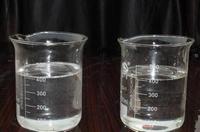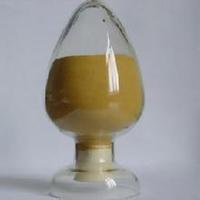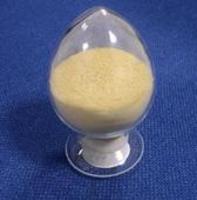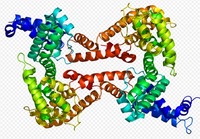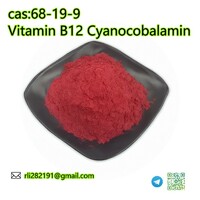Vitamin B6
Product Quick Detail
- China
- mainland
- Packaging
- N/A
- Delivery
- 6 Days
Specifications
Vitamin B6
Vitamin B6 (Vitamin B6) is also called pyridoxine. Is a water soluble vitamin, meet light or alkali easy to destroy, not resistant to high temperature. A containing pyridoxine or pyridoxal or
pyridoxamine B vitamins. In 1936 named vitamin B6. Vitamin B6 is a colorless crystal, easily soluble in water and ethanol, the acid in the stable, easy to damage, in alkaline solution heat of
pyridoxine, pyridoxal and pyridoxamine not resistant to high temperature. The more the content of vitamin B6 in yeast, liver, meat, fish, Gu Li, eggs, beans and peanuts. Vitamin B6 is the body
composition of certain coenzymes, involved in a variety of metabolic reactions, especially closely related to amino acid metabolism. Clinical application of vitamin B6 preparation for preventing
vomiting and radiation sickness and vomiting of pregnancy.
[alias] Drug pyridoxine hydrochloride, pyridoxine, Pyridoxine
The chemical properties of [] containing pyridoxine or pyridoxal or pyridoxamine B vitamins. The acid in the stable, easy to damage, in alkaline solution heat of pyridoxine, pyridoxal and
pyridoxamine not resistant to high temperature.
The physical properties of vitamin B6 [] is a colorless crystal, easily soluble in water and ethanol.
[molecular formula 1] China Pharmacopoeia "C8H11NO3 HCl"
[molecular formula 2] commonly used molecular formula C8H10NO5P
[molecular formula 3] pyridoxine C8H11NO3
[molecular formula 4] pyridoxal C8H9NO3
[molecular formula 5] pyridoxamine C8H12N2O2
[CAS], 65-23-6
[EINECS], 277-913-8
The requirements of Pharmacopoeia
The product is 6- methyl -5- hydroxy -3,4 pyridine two methanol hydrochloride, measurement according to the dry grains, containing C8H11NO3 HCl should be 98.0%-102.0%
Characters of the product is white or white crystal or crystalline powder, odorless, bitter in taste, light gradient matter. Soluble in water, slightly soluble in ethanol, insoluble in chloroform
or ether.
Acidity the product 1.0g, add 20ml of water so that dissolved, the measured PH should be 2.40-3.00.
The loss on drying of the product, at 105 DEG C dried to constant weight loss weight not exceeding 0.5%
Burning residue shall not exceed 0.1%
Heavy metal shall not exceed 10ppm
Found in nineteenth Century, pellagra (pellagra) in addition to being found nicotinic acid deficiency, in 1926 discovered another vitamin deficiency in the feed, can also cause small mice induced
pellagra, and later this material in 1934 was named vitamin B6, until 1938~1939 was isolated, and the qualitative and able to synthesize vitamin B6.
Chemical composition: vitamin B6 is known as the duo substance refers to the ratio, because of containing vitamin B6 active substance that is belonging to pyridoxine (pyridoxine), but the function
of three kinds of chemical form:
The pyridoxine (pyridoxol),
The pyridoxal phosphate (pyridoxal),
The pyridoxamine (pyridoxamine).
The molecular formula of pyridoxine (C8H11NO3), 2 (C8H9NO3), the pyridoxal pyridoxamine (C8H12N2O2).
The molecular formula is commonly used in C8H10NO5P
This substance is soluble in water and alcohol colorless crystalline body, because of containing salt (NaCl) component, so with a little salty taste. This kind of material is not sensitive to heat,
but the encounter alkaline substances, or ultraviolet light of the class, will decompose. Hydrochloric acid is about 204 DEG ~206 DEG pyroxidine melting point.
Food sources:
In animal and plant food content of micro - and most yeast powder content, content of rice bran or rice also many, the second is from the meat, poultry, fish, potatoes, sweet potatoes, vegetables.
Every 100g of edible part in foods containing vitamin B6 content is as follows: 3.67mg 2.91mg yeast powder, defatted rice bran, rice 2.79mg, flaxseed meal 1.25mg, custard 0.8 ~ 0.04mg, carrot
0.7mg, fish 0.45mg, whole wheat extracts of 0.4 ~ 0.7mg, 0.3 ~ 0.08mg, meat, milk and eggs of 0.3 ~ 0.03mg, 0.25mg, 0.22mg in spinach. Sweet potato is 0.14 ~ 0.23mg, pea 0.16mg, soybean 0.1mg,
orange 0.05mg.
Drug description:
Tablet: each tablet 10mg. Injection; each 25mg (1ml); 50mg (1ml); 100mg (2ml).
Cream: each containing 12mg.
Vitamin B6 sustained-release tablet: each tablet 50mg. A 50mg, a day 1 ~ 2 times.
Compound vitamin B tablet: each tablet contains B13mg, B21.5mg, B60.2mg, nicotinamide 10mg. Take 1 to 2 tablets each time, 1 3 times a day.
Compound vitamin B injection: each containing B120mg, B22mg, B62mg, 30mg (2ml) of nicotinamide. Intramuscular injection of 2ml each time, 1 times a day.
Pharmaceutical grade
The content of 99%
- Country: China (Mainland)
- Business Type:
- Market:
- Founded Year:2010
- Address:No.496,Zhongshan Road, Wuhan, Hubei, China
- Contact:Cassie Lee
Other products from 武汉远程共创科技发展有限公司
Relate products of Vitamin B6
25-OH Vitamin D
Vitamin D Antibody Vitamin D is an important hormone that regulates calcium and phosphorus metabolism in the body. The skin mainly synthesizes it under sunlight conditions, and a small amount can obtain through diet. The active form of vitamin D is especially 1,25 dihydroxy ...
cas:68-19-9 Vitamin B12 Cyanocobalamin 99% food grade
cas:68-19-9 Vitamin B12 Cyanocobalamin 99% food grade Packing 1kg/bag,5kg/bag or 25kg/Hardboard drum or as your requirment 1KG : Double pharma-grade polybag inside,sealed Aluminum foil bag outside 5KG : Double pharma-grade polybag inside,Hardboard cartons outside 25KG: Double ...
Advanced Immune Defense Multi-Vitamin
AID™ is a high potency multiple vitamin, mineral and phyto-nutrient supplement that provides optimum nutritional & antioxidant support for your cells and immune ...

